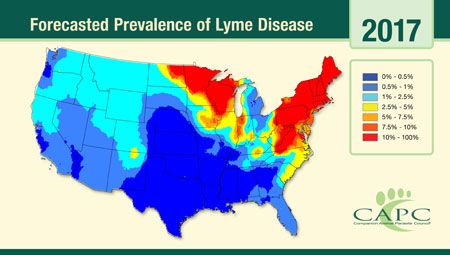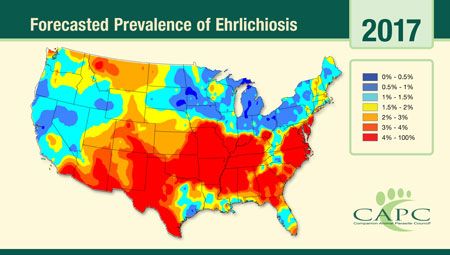2017 parasite forecast maps predict uptick in heartworm, Lyme infections
With these two diseases growing both beyond and within their endemic bounds, CAPC hopes veterinarians use the predictions to encourage prevention and testing.
Veterinarians in many areas of the country should expect higher-than-average caseloads of both Lyme disease and heartworm infections this year, according to the recently released annual parasite forecast maps from the Companion Animal Parasite Council (CAPC). The maps, which also include ehrlichiosis and anaplasmosis forecasts, are put together by parasitologists and statisticians using factors such as weather patterns, human population density and wildlife distribution, CAPC says on its website.
2016 heartworm incidence survey results from the American Heartworm Society
The American Heartworm Society (AHS) surveys practices and shelters across the U.S. every three years. Here's a quick overview of the results from 2016:
While heartworm case distribution hasn't changed much since 2013, the average number of cases per clinic has risen nearly 22 percent. Click here to see the 2016 incidence map.
Around 23 percent of respondents saw an increase in cases compared with 2013, and almost 20 percent reported a decline.
The top 10 states for heartworm incidence are Mississippi, Louisiana, Arkansas, Texas, Tennessee, South Carolina, Georgia, North Carolina, Alabama and Florida. Though in the top tier, Alabama, Louisiana and Texas reported decreases in heartworm cases. The other seven saw increases.
64 percent of veterinarians who reported a decrease in heartworm cases credited owner compliance. Around 48 percent of veterinarians who reported an increase blamed owner compliance.
Source: AHS
A release from the council highlights the effect of milder temperatures and increased precipitation on the mosquito population. “Shifting weather patterns have created ideal breeding conditions for mosquitoes across the country,” the release states.
CAPC board member and Cornell University parasitology professor Dwight Bowman, PhD, explains in the release that the forecasts “help veterinarians and pet owners understand parasites are a true risk to both pets and people. This year, there are significant shifts in prevalence, making our maps a critical education tool for veterinarians to use to demonstrate to pet owners that parasites are ever-changing and widespread, sometimes surprisingly so.”
Click through the four nationwide CAPC parasite forecast maps below. To see prevalence data by county, visit capcvet.org.

All images courtesy of the Companion Animal Parasite CouncilHeartworm disease activity is expected to be higher across the United States this year-even in the Rockies and westward-thanks to higher temperatures and above-average rainfall in 2016. The hyperendemic Lower Mississippi Valley is expected to see even more infections than usual, while western Texas (from Amarillo to Laredo) is the only area that may see lower caseloads.
*Need more ideas for acheiving better client compliance? Check out our heartworm prevention toolkit!

Lyme disease is also expected to expand beyond its endemic boundaries in 2017, so veterinarians in North and South Dakota, Iowa, Missouri, southern Illinois, Ohio, Kentucky, Tennessee and North Carolina should be on high alert regarding this zoonotic disease. Areas where Lyme disease is already endemic, including western Pennsylvania, New York, northwestern Wisconsin and northern Minnesota, are expected to see higher caseloads, while caseloads along the Atlantic seaboard (from Washington, D.C., to Boston) are predicted to remain static.
*Pssst! Check out this client handout on 7 Lyme disease myths!

Ehrlichiosis. Ehrlichia species “can be nonexistent to rampant within 200 miles,” the release says. It is expected to be especially active in eastern Oklahoma, the Ohio River Valley, southern Virginia, northern North Carolina, eastern Oregon and western Montana. But the Great Plains regions may see below-average activity.

Anaplasmosis. Anaplasma species are expected to continue to plague northern California and southern Georgia this year. New York and western Pennsylvania are also expected to have an active year, but Minnesota and Wisconsin, typical anaplasmosis hotspots, may have below-normal prevalence.